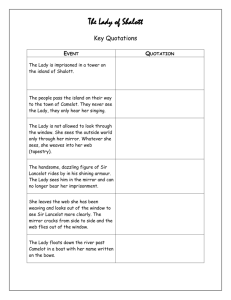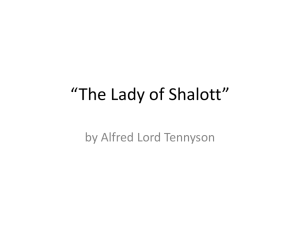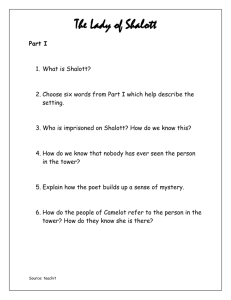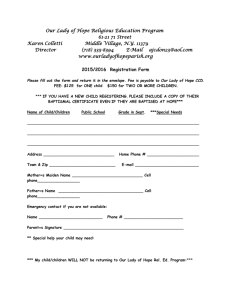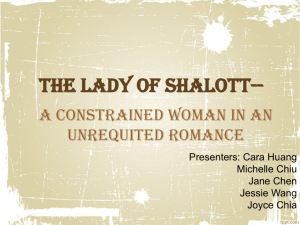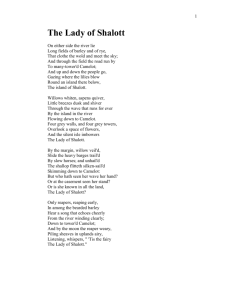A Cultural Approach to EFL: A “Voyage of the Senses” with A
advertisement
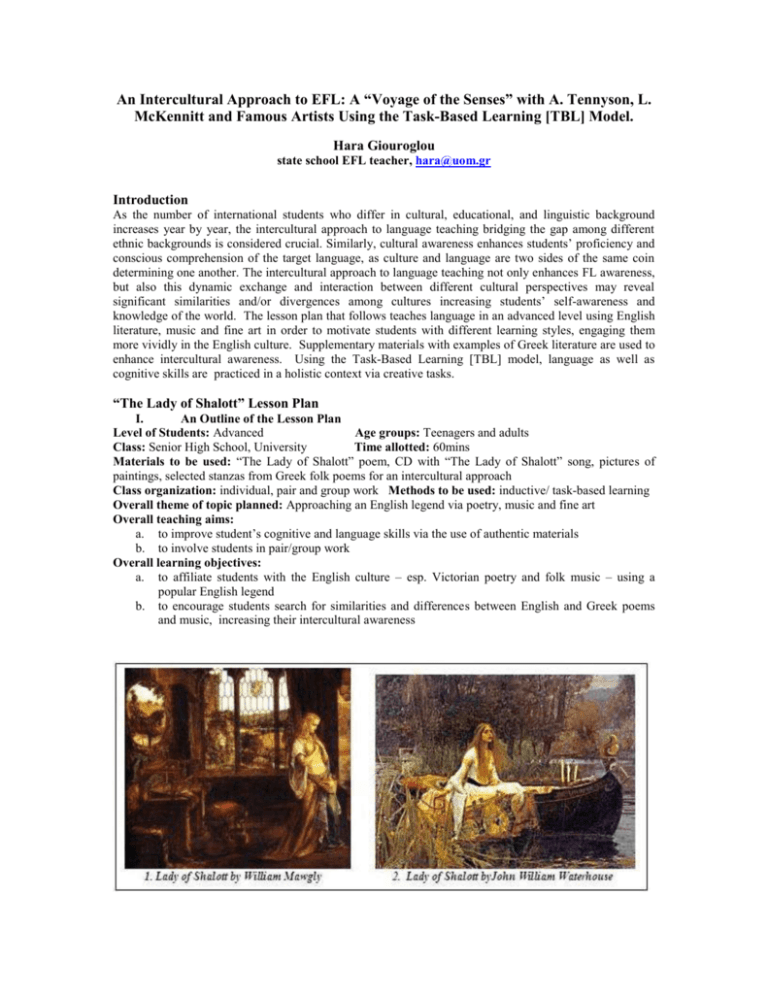
An Intercultural Approach to EFL: A “Voyage of the Senses” with A. Tennyson, L. McKennitt and Famous Artists Using the Task-Based Learning [TBL] Model. Hara Giouroglou state school EFL teacher, hara@uom.gr Introduction As the number of international students who differ in cultural, educational, and linguistic background increases year by year, the intercultural approach to language teaching bridging the gap among different ethnic backgrounds is considered crucial. Similarly, cultural awareness enhances students’ proficiency and conscious comprehension of the target language, as culture and language are two sides of the same coin determining one another. The intercultural approach to language teaching not only enhances FL awareness, but also this dynamic exchange and interaction between different cultural perspectives may reveal significant similarities and/or divergences among cultures increasing students’ self-awareness and knowledge of the world. The lesson plan that follows teaches language in an advanced level using English literature, music and fine art in order to motivate students with different learning styles, engaging them more vividly in the English culture. Supplementary materials with examples of Greek literature are used to enhance intercultural awareness. Using the Task-Based Learning [TBL] model, language as well as cognitive skills are practiced in a holistic context via creative tasks. “The Lady of Shalott” Lesson Plan I. An Outline of the Lesson Plan Level of Students: Advanced Age groups: Teenagers and adults Class: Senior High School, University Time allotted: 60mins Materials to be used: “The Lady of Shalott” poem, CD with “The Lady of Shalott” song, pictures of paintings, selected stanzas from Greek folk poems for an intercultural approach Class organization: individual, pair and group work Methods to be used: inductive/ task-based learning Overall theme of topic planned: Approaching an English legend via poetry, music and fine art Overall teaching aims: a. to improve student’s cognitive and language skills via the use of authentic materials b. to involve students in pair/group work Overall learning objectives: a. to affiliate students with the English culture – esp. Victorian poetry and folk music – using a popular English legend b. to encourage students search for similarities and differences between English and Greek poems and music, increasing their intercultural awareness II. Teacher’s Background Information The teacher needs some background information regarding Alfred Tennyson, Loreena McKennitt and the Lady of Shalott legend that he/she will share with the students at some point during the lesson tasks. Alfred Tennyson (1809 - 1892) was Poet Laureate of the United Kingdom and is often regarded as the chief representative of the Victorian age in poetry. He held the position of Poet Laureate - a poet officially appointed by a government to compose poems for state occasions and other government events – from 1850 until his death. Queen Victoria, an admirer of Tennyson's work, created him Baron Tennyson in 1884. Loreena McKennitt is a self-managed Canadian singer/composer and the head of her own internationally successful record label, Quinlan Road. In her recording career, McKennitt's “eclectic Celtic” music has won critical acclaim worldwide and gold, platinum and multi-platinum sales awards in fifteen countries across four continents. “The Lady of Shalott” is Tennyson’s epic Arthurian poem one of Loreena’s best-loved creations. It has inspired painters throughout the nineteenth century and well into the twentieth. The Lady of Shalott is a magical being who lives alone on an island upstream from King Arthur's Camelot. Her business is to look at the world outside her castle window in a mirror, and to weave what she sees into a tapestry. She is forbidden by the magic to look at the outside world directly. One day, she sees the reflection of Sir Lancelot riding alone. Although she knows that it is forbidden, she looks out the window at him and the curse fells on her. The mirror breaks and flies away. The lady leaves her castle, gets into the boat, writes her name on it, sets it adrift, and sings her death song as she drifts down the river to Camelot. Lancelot prays that God will have mercy on her soul. The Lady of Shalott Lyrics [red words are hidden to students] 1. On either side of the river lie Long fields of barley and of rye, That clothe the world and meet the sky; And thro' the field the road run by To many-towered Camelot; 2. And up and down the people go, Gazing where the lilies blow Round an island there below, The island of Shalott. 3. Willows whiten, aspens quiver, Little breezes dusk and shiver Thro' the wave that runs forever By the island in the river Flowing down to Camelot. 4. Four grey walls, and four grey towers, Overlook a space of flowers, And the silent isle imbowers The Lady of Shalott. 5. Only reapers, reaping early, In among the bearded barley Hear a song that echoes cheerly From the river winding clearly Down to tower'd Camelot; 6. And by the moon the reaper weary, Piling sheaves in uplands airy, Listening, whispers "'tis the fairy The Lady of Shalott." 7. There she weaves by night and day A magic web with colours gay, She has heard a whisper say, A curse is on her if she stay To look down to Camelot. 8. She knows not what the curse may be, And so she weaveth steadily, And little other care hath she, The Lady of Shalott. 9. But in her web she still delights To weave the mirror's magic sights, For often thro' the silent nights A funeral, with plumes and with lights And music, went to Camelot; 10. Or when the Moon was overhead, Came two young lovers lately wed. "I'm half sick of shadows," she said The Lady Of Shalott. 11. A bow-shot from her bowereaves, He rode between the barley sheaves, The sun came dazzling thro' the leaves, And flamed upon the brazen greaves Of bold Sir Lancelot. 12. A red-cross knight for ever kneel'd To a lady in his shield, That sparkled on the yellow field, Beside remote Shalott. 13. His broad clear brow in sunlight glow'd; On burnish'd hooves his war-horse trode; From underneath his helmet flow'd His coal-black curls as on he rode, As he rode back to Camelot. 14. From the bank and from the river he flashed into the crystal mirror, "Tirra Lirra," by the river Sang Sir Lancelot. 15. She left the web, she left the loom, She made three paces thro' the room, She saw the water-lily bloom, She saw the helmet and the plume, She looked down to Camelot. 16. Out flew the web and floated wide; The mirror cracked from side to side; "The curse is come upon me," cried The Lady of Shalott. 17. In the stormy east-wind straining, The pale yellow woods were waning, The broad stream in his banks complaining. Heavily the low sky raining Over towered Camelot; 18. Down she came and found a boat Beneath a willow left afloat, And round about the prow she wrote The Lady of Shalott 19. And down the river's dim expanse Like some bold seer in a trance, Seeing all his own mischance With a glassy countenance She looked to Camelot. 20. And at the closing of the day She loosed the chain and down she lay; The broad stream bore her far away, The Lady of Shalott. 21. Lying, robed in snowy white That loosely flew to left and right -The leaves upon her falling light -Thro' the noises of the night, She floated down to Camelot: 22. And as the boat-head wound along The willowy hills and fields among, They heard her singing her last song, The Lady of Shalott. 23. Who is this? And what is here? And in the lighted palace near Died the sound of royal cheer; And they crossed themselves for fear, The Knights at Camelot; 24. Lancelot mused a little space He said, "She has a lovely face; God in his mercy lend her grace, The Lady of Shalott." III. The TBL Model Pre-Task [2-3 mins] The teacher asks students if they have ever listened to Celtic music and if they know anything about the legend of Camelot, Sir Lancelot and the Lady of Shalott. Then, the Lady’s painting No.2 is shown to students and they are asked to describe the scene and the Lady in terms of appearance and disposition. Task 1 [10mins] The students listen to L. McKennith’s song, looking for the missing words. Some task questions are: Which missing words were you able to find? Who is the woman in the picture? What has happened to her? Task 2 – Specific content questions/discussion [15 mins] Students in pairs or groups skim the poem, trying to understand the storyline. Each group writes down the story on pieces of paper which the teacher collects and hands them out to the groups randomly, so that each group has the opportunity to see and discuss/debate upon what their peers wrote, making corrections or additions on the drafts. A more in-depth discussion on the story starts. Now the teacher can reveal more specific information. Students in pairs are asked to underline with green pen the lines that describe the scenery and with red pen the lines that narrate the story in every verse. They will detect that some stanzas [e.g. 7] narrate the story, whereas others [e.g. 1] describe the scenery. The teacher can also encourage students to scan the text in order to find clues of the four seasons. It will be revealed to them that the narration starts in spring [3: Willows whiten, aspens quiver/Little breezes dusk and shiver], then comes summer [11. He rode between the barley sheaves], autumn [17: In the stormy east-wind straining] and finally winter [21: Lying, robed in snowy white] which is also a metaphor of a human’s life circle. Now, students are shown all pictures and are asked to identify the stanzas that describe them and put pictures in the correct chronological order. Task 3 – Focus on language [10 mins] The teacher encourages students to guess the remaining missing words via the help of rhyming when the missing word is the last on the line or by giving them some semantic/grammatical clues [e.g. 1: “To manytowered Camelot” Camelot is a castle, and castles have many t****s]. Now, students can scan the text for specific word groups such as plants and trees [lily, willow, aspen, barley, rye] and for words used metaphorically [e.g.1: “fields of barley and of rye,/That clothe the world and meet the sky”], that also enhance their narrative writing skills. To add, students are asked to identify the meaning of the word “gay” in 7 as it is not widely used with its literal meaning nowadays. Students are reminded that this word is also found in the Christmas Carols Deck the Halls “Don we now our gay apparel” and it means “cheerful/lively/merry”. To achieve a more in-depth linguistic analysis, students can be asked to underline with blue pen the archaic English words and try to guess their modern English equivalents [e.g. 8: “weaveth” = weaves, “hath” = has]. Task 4 – Focus on grammar [5 mins] In this task students are asked to identify the tenses in the poem. They will come up with two prevailing tenses, the Simple Past and Simple Present. The next question is why the Simple Present is used in a story. Then, the teacher introduces the Historic Present Tense. Verbs in the "historic present" describe something that happened in the past, when the facts are listed as a summary, providing a sense of urgency. Task 5 – Intercultural Approach [10-15 mins] At this point, students are fully aware of the plot and can now find similarities and/or differences between the poem and the Greek literature. They can be handed out a sheet with various verses from Greek poems such as the cretan medieval romance “Ερωτόκριτος”: στ: 517-520, “Ήρθεν λαός αρίφνητος, εγέμισεν ο φόρος/στο ύστερον ο Ρωτόκριτος ήσωσεν ασπροφόρος σ’ένα φαρίν ολόμαυρο, το’να του πόδι είν’άσπρο/ και μέσα σ’όλους ήλαμπεν οσάν της μέρας τα’άστρο”, where students can compare the description of Ερωτόκριτος to Sir Lancelot, or from folk poems such as “Μια Λυγερή βαριαρρωστά, μια λυγερή πεθαίνει/για ενός αγούρου αγκάλιασμα, για ενός αγούρου αγάπη” and “Αγγελοστολισμένη μου, ποιος σού δωκε τη χάρη/να σαϊττεύεις τις καρδιές δίχως να χεις δοξάρι;” that bears similarities to stanza 11: “A bowshot from her bower-eaves”. In case there is more time available, students may listen to “ΕρωτόκριτοςΚρητικός” as composed and narrated by Nikos Xydakis, searching for similarities and differences in melody and instruments between the two performances. Moreover, the teacher can ask students to look closely at painting No.3 and say if they can think of any Greek heroine who spent a large part of her life weaving and waiting for someone, and they will surely come up with Penelope. Students can be also asked to find linguistic and cultural differences between the word “fairy” [6: having two possible interpretations in this context] and its Greek equivalent “νεράιδα” in terms of word origins: “fairy” stems from “fair” which means “blond”, “beautiful” and “righteous” and fairies in all cultures are beautiful, faircomplexioned and righteous beings, while “νεράιδα” stems from “νερό” and are considered to be dwelling in rivers and lakes [even though the Greek mythology has different names for fairies dwelling in trees, caves or waters]. Again, there is another similarity as the Lady of Shalott dies on a river-boat. Students are asked to comment on a statement made by Loreena: “I found myself drawn into a rich, ancient tapestry of sounds and rhythms and stories. I discovered myths and traditions that resemble one another from far corners of the globe, people who share traits and yet are distinctive” and “we are a culmination of our collective histories and there should be more to bind us together than tear us apart”. What is McKennitt’s opinion regarding world cultures? How does she justify this? Do you agree or disagree with her statement? Task 6 – Focus on composition writing [Homework], [2 mins] Inspired by the legend, students are encouraged to narrate the whole story of the Lady of Shalott in a well-structured essay, or to write a comparison and contrast essay of Tennyson’s poem and a Greek one as their homework. Students may spend the last 5 minutes enjoying Loreena’s marvelous performance! Conclusion Teaching needs to provide unique learning experiences that not only increase language competence but also contribute to intercultural awareness enhancement as well as personal development and cultivation. Authentic materials and TBL promote students’ cognitive skills development and make the lesson more interesting and appealing to their individual learning styles. References Chryshochoos, J.E. et al. (2002) The Methodology of the Teaching of English as a Foreign Language with Reference to the Crosscurricular Approach and Task-Based Learning. Athens: The Pedagogical Institute. Gardner, H. (1999) Intelligence Reframed: Multiple Intelligences for the 21st Century. Basic Books. Kelly, M. et al. A Frame of Reference. A Report to the European Commission Directorate General for Education and Culture. September 2004, European Profile for Language Teacher Education. The Official Website of Loreena McKennitt, Quinlan Road: http://www.quinlanroad.com

